IN THIS ISSUE
- The stinging season
- Mussel invader caught (again)
- Reader survey and cap giveaway
- Animal architects: meet the collectors
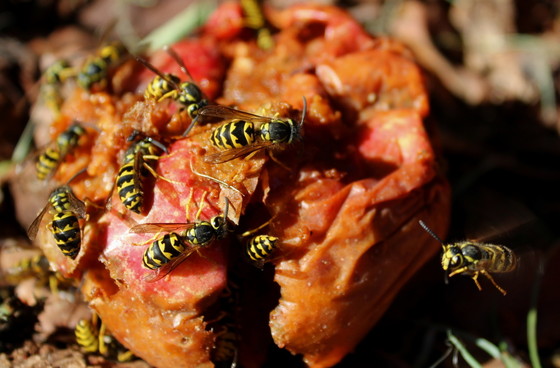 Yellow jackets enjoy a rotting apple
By TERRY W. JOHNSON
I can safely say I don’t know anybody who has a kind word to say about yellow jackets.
Yet it seems that folks most often talk about their dislike for the half-inch-long yellow-and-black wasps in the summer and fall. I suppose it’s because we seem to encounter them more often during these seasons.
But like them or not, yellow jackets are interesting. Here’s what I mean …
Read Terry’s column to explore the lives of these reviled insects.
Terry W. Johnson is a retired DNR program manager and executive director of TERN, friends group of the agency's Wildlife Conservation Section. Check out past columns, his Backyard Wildlife Connection blog and his book “A Journey of Discovery: Monroe County Outdoors.” Permission is required to reprint a column.
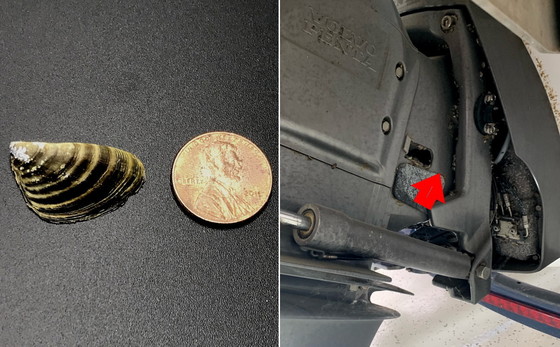 Zebra mussel up close and hitchhiking on the boat last month (arrow points to clusters)
Another year, another close call with zebra mussels at Lake Lanier.
A sharp-eyed boat owner contacted DNR in July after noticing odd-looking mussels clustered along parts of the boat’s motor. Closer inspection revealed the tiny hitchhikers were zebra mussels.
Thankfully, the owner called before putting his boat in Georgia’s busiest lake.
Why the worry? The dime-sized mollusks native to eastern Europe are an aquatic plague in North America. Zebra and quagga mussels, another European interloper, multiply fast and furious, clogging water plant pipes, coating boats and jumping the food chain, crowding out native mussels and affecting fish and other wildlife.
Jim Page, DNR aquatic nuisance species coordinator, said Georgia has no known population of zebra mussels. With the public’s help, he hopes to "keep that streak going.”
But the scares are becoming more frequent as the mussels spread across the U.S. DNR responded to two incidents in 2021: zebras found in moss balls sold for aquariums and clinging to another boat bound for Lanier.
Vigilance and prevention are key. Boaters are urged to take part in the national clean, drain, dry initiative, which centers on decontaminating boats before they are launched in new waters. Georgians should also report non-native aquatic species to a local DNR office and remove any such animals or plants they catch or collect.
Learn more at georgiawildlife.com/ans.
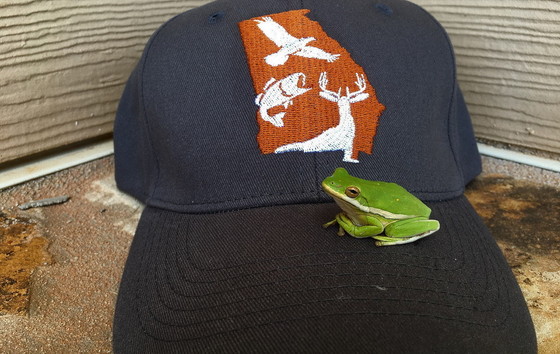 Annual reader survey includes a drawing for DNR caps (minus the green treefrog)
Your 2 cents for a chance at a cool cap?
Complete the annual Georgia Wild reader survey and we will not only take your feedback to heart, we’ll enter your email in a drawing for a coveted Wildlife Resources Division hat.
Actually, you can’t lose. Whether or not you land a cap, your comments will help improve Georgia Wild. That means more of the wildlife conservation news you want, plus a few fun surprises, delivered free to your inbox each month.
Deal? Deal.
Click the button below, take the survey (seven minutes tops) and add your email. But do it now. The survey closes Aug. 26. Winners will be notified by Sept. 2. The September e-newsletter will include highlights of survey results.
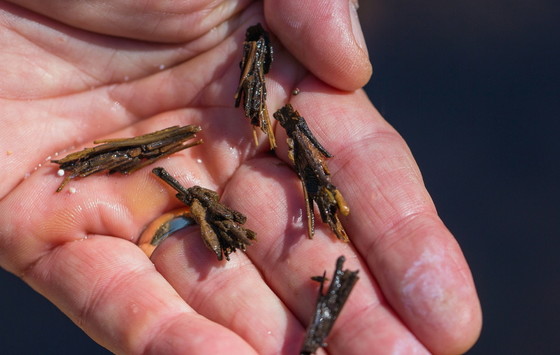 Caddisfly larvae in cases made of twigs and other debris (USFWS)
By ETHAN HATCHETT
The natural world is full of discarded items. Leaves fall, branches break, animals die.
But some creatures profit from what’s left behind. Nature’s trash is their treasure.
These "collectors" vary from case-building caddisflies, whose larvae assemble makeshift armor from pebbles, twigs and other objects, to young green lacewings, which camouflage themselves with bits of organic matter, including the remains of insects they've eaten.
For insight into these skilled savers, see part two of our Animal Architects series.
Ethan Hatchett is a communications assistant in DNR’s Wildlife Conservation Section.
 Loggerhead hatchlings head for the Atlantic (Mark Dodd/DNR)
First bald eagles, now loggerheads. It has been a state-record year for both iconic species, with Georgia’s primary nesting sea turtle becoming the latest to post a modern-day best -- 4,000-plus nests as of Monday, which tops the previous high of 3,950 set in 2019. Sea Turtle Program Coordinator Mark Dodd cautioned, though, that loggerheads are on a long if promising path to recovery. Current trends suggest “it will take at least another 20 years before we reach our recovery goals.”
Did we mention that red-cockaded woodpeckers also had a standout nesting season? On wildlife management areas and private lands in the Safe Harbor Program, DNR monitored 63 breeding groups of the rare birds and banded 83 nestlings, including a record 54 young at Silver Lake WMA near Bainbridge.
 UGA graduate students with a whopper lake sturgeon on the Coosa (Special to DNR)
A 4-foot-plus lake sturgeon landed by University of Georgia researchers on the Coosa River is the largest recorded since DNR began restoring the fish to the Coosa in 2001. Before its release, the 52-inch-long, 24-pound sturgeon was implanted with a radio tag. Lake sturgeon are protected; release and report any caught to DNR at (706) 295-6102. (Related: "Prehistoric fish poised for a comeback," UGA Today.)
Educating educators, DNR helped lead this year’s Teacher Conservation Workshop and Charlie Elliott Wildlife Center again coordinated the Advanced Project Wild’s Outdoor Wildlife Leadership School. The four-day workshop immersed 18 teachers in Georgia’s forests and their benefits, while OWLS had 16 more teachers exploring coastal ecosystems, from learning habitat-focused activities to watching sea turtle hatchlings scramble for the surf.
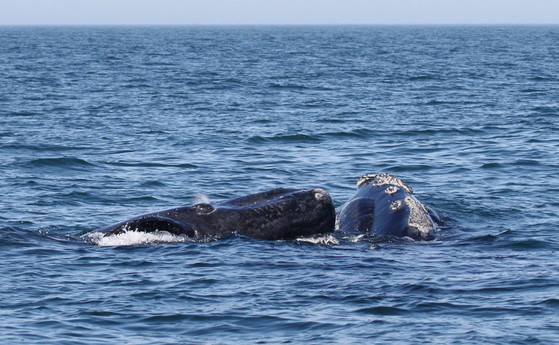 Right whale mom and calf off Sea Island (DNR/NMFS permit 15488)
New vessel speed regulations and a guide to using more “ropeless” commercial fishing gear headline NOAA's proposed rule changes to further protect endangered North Atlantic right whales. With vessel strikes and entanglements causing most deaths and injuries for the endangered whales, one proposal would lower from 65 to 35 feet the length of vessels that must follow a 10-knot limit in seasonal speed zones, including in the Southeast. Learn more in webinars scheduled for 6-7:30 p.m. today and Aug. 24 (registration required). Comments are due by Sept. 30.
DNR’s botany team continues to spot rare plants in new places. The species include pink lady’s slipper orchids and critically imperiled northern shorthusk grass in White County and western swamp milkweed – known only from one other tract in Georgia – near Roswell (botanist Amaad Blades is researching whether the milkweed might have been planted at the new site).
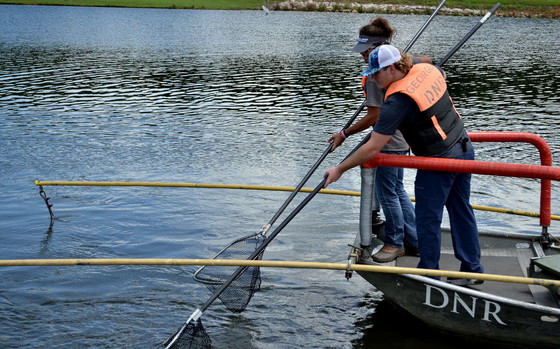 Hands-on lesson in fish sampling for Career Academy teens (DNR)
Quick hits:
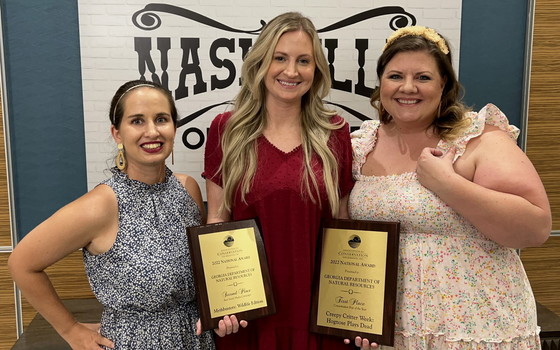 Denise Shepherd, center, with WRD Public Affairs Assistant Manager Aubrey Pawlikowski and Manager Lacey Creech
Names in the news: Social media coordinator Denise Shepherd of DNR’s Wildlife Resources Division landed a one-two awards punch at the Association for Conservation Information conference in Nashville, Tenn. Shepherd earned first for Conservation Post of the Year (“Creepy Critters Week: Hognose Plays Dead”) and second in Best Social Media Campaign (“Mythbusters: Wildlife Edition”). DNR game warden Brock Hoyt has received a Torch Award, the North American Wildlife Enforcement Officers Association honor that recognizes “up-and-coming” young wardens in each U.S. region. “Entangled,” an award-winning documentary about “the race to save right whales,” has been nominated for an Emmy.
WHAT YOU MISSED ...
In the previous Georgia Wild:
- Record eagle nest results
- Georgia's wildest architects
- Winter hummers in summer
"Sea turtles crawl to nesting record on Georgia coast," The Associated Press, and others including The Christian Index, The Albany Herald
"Proposed federal speed rule could further protect right whales," The Post and Courier (Charleston, S.C.). Also: The Associated Press, The Weather Channel (video), Florida Politics. Related: "Court reinstates ban on lobster gear to protect right whales," The Associated Press.
(+video) "Entangled right whale’s condition has worsened," CTVNews (Ontario, Canada)
(+audio) "Bald eagle populations soar in Georgia," WUGA-FM (91.7, 94.5, Athens). Also: Atlanta Journal-Constitution, Georgia Public Broadcasting, The Georgia Virtue.
"Boater’s keen eye kept invasive hitchhiker out of Georgia lake," The (Macon) Telegraph
"Big bipartisan wildlife bill could be headed to Biden's desk," The Washington Post
"Bat blitz returns to the Bankhead," Northwest Alabamian
"Biologists want your help tracking hellbender salamander," Georgia Public Broadcasting. Also: Chattanooga Times Free Press, The (Macon) Telegraph.
"Trespass warnings on Georgia rivers roil waters," Georgia Recorder
"Bill could threaten wildlife funding," Georgia Outdoor News
"Georgia Outdoor Stewardship helps fund Satilla estuary restoration," AllonGeorgia
"Gainesville police warn of bear sightings in city," WXIA-TV (ch. 11, Atlanta)
"Trees are overrated: preserving the world's great expanses of grass," The Atlantic
"‘Unusual:’ Feds investigate seal deaths linked to avian flu," The Associated Press
"Students graduate from inaugural DNR Career Academy," EIN
(+audio) "Why Muscogee Nation gets say in Okefenokee mine proposal," WABE-FM (90.1, Atlanta)
(+video) "Coyote raids sea turtle nests on Tybee Island," WTOC-TV (ch. 11, Savannah)
"Sea turtle conservation gets boost from new DNA method," University of Florida (study: Molecular Ecology Resources)
"New hypothesis on why woodpeckers don't get brain damage," ScienceAlert (study: Current Biology)
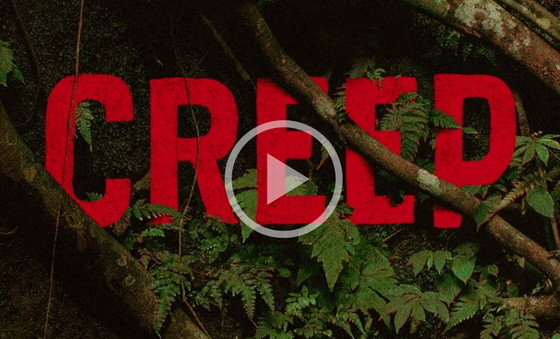 (audio) "Black and white and banned all over -- almost," CREEP podcast on tegus including DNR's Daniel Sollenberger, WUNC-FM (91.5, Chapel Hill, N.C.). Related: "Giant lizards have reptile superpower that may help them thrive," WUNC-FM.
"Bald eagle surveys with Bob Sargent" (DNR). Related (audio): "DNR biologist discusses Georgia's bald eagle population," AccessWDUN, Gainesville.
Alabama shiners exhibiting spawning behavior (aka "doin' a dancey dance"), DNR
Doe freed from Gatorade bottle stuck on snout, DNR Urban Wildlife Program
"Recovering America's Wildlife Act: Elk Hunting with New Mexico Sen. Martin Heinrich," Project Upland Magazine (article)
Ranger Nick on aquatic invasive species, Georgia Farm Monitor
Flightless Guillemot chick's first jump from cliff into sea, Sam Langlois
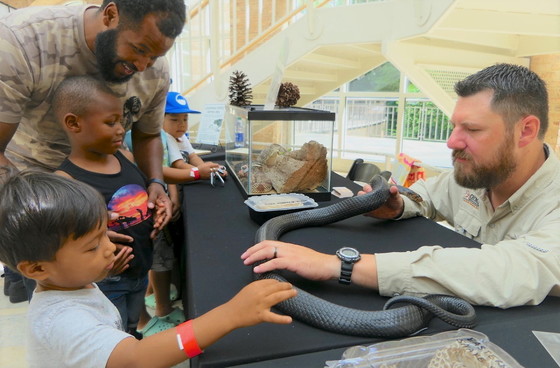 DNR senior wildlife biologist Daniel Sollenberger shows an eastern indigo snake to visitors at Fernbank Museum’s Reptile Day. More than 2,000 people attended the event at the Atlanta center. Along with Sollenberger, DNR Wildlife Conservation Section staff members Marylou Horan, Linda May and Jacob Wilson used “animal ambassadors” also including other snakes, a gopher tortoise and a spotted turtle to inform the crowd about Georgia reptiles.
CREDITS
Masthead: zebra mussels
Parting shot: Reptile Day at Fernbank (Linda May/DNR)
Top
|